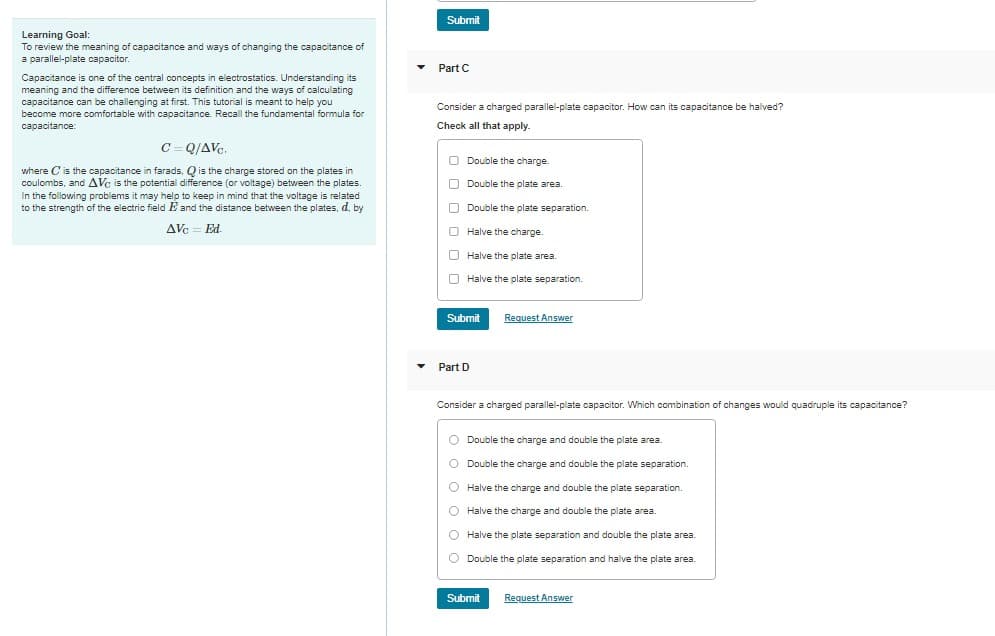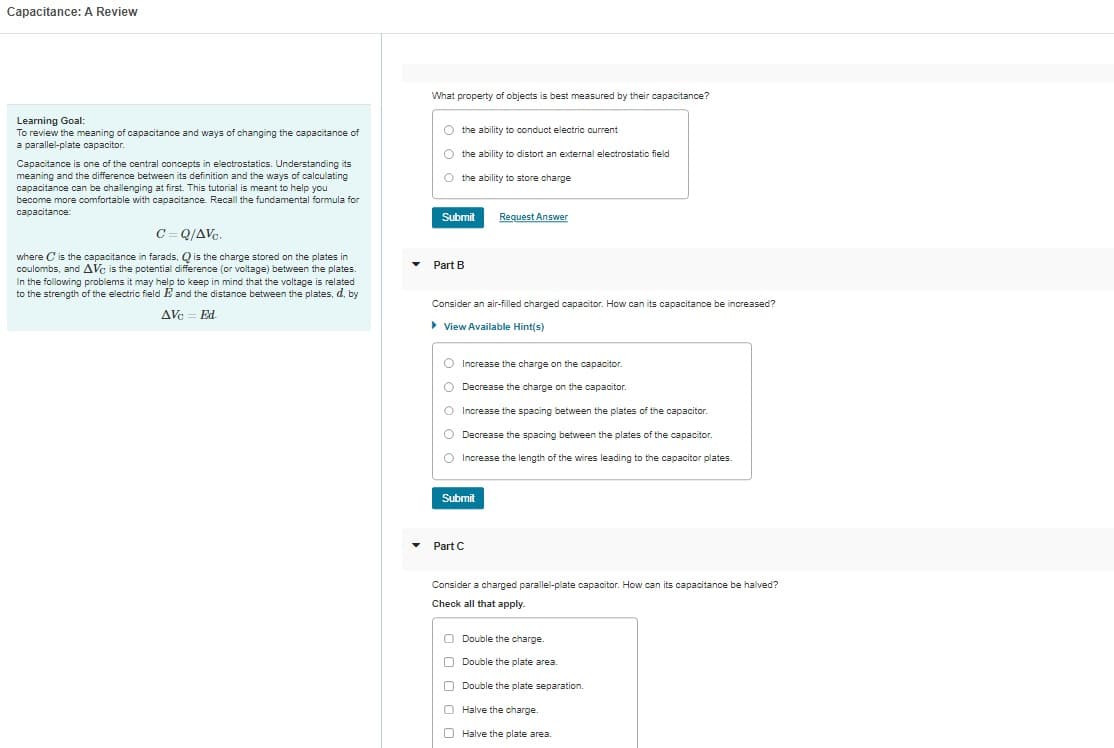Learning Goal: To review the meaning of capacitance and ways of changing the capacitance of a parallel-plate capacitor. Capacitance is one of the central concepts in electrostatics. Understanding its meaning and the difference between its definition and the ways of calculating capacitance can be challenging at first. This tutorial is meant to help you become more comfortable with capacitance. Recall the fundamental formula for capacitance: C=Q/AVC. where C is the capacitance in farads. Q is the charge stored on the plates in coulombs, and AVC is the potential difference (or voltage) between the plates. In the following problems it may help to keep in mind that the voltage is related to the strength of the electric field E and the distance between the plates, d, by Ed. AVe What property of objects is best measured by their capacitance? O the ability to conduct electric current O the ability to distort an external electrostatic field O the ability to store charge Submit Part B Consider an air-filled charged capacitor. How can its capacitance be increased? ▸ View Available Hint(s) O Increase the charge on the capacitor. O Decrease the charge on the capacitor. O Increase the spacing between the plates of the capacitor. O Decrease the spacing between the plates of the capacitor. O Increase the length of the wires leading to the capacitor plates. Submit Request Answer Part C Consider a charged parallel-plate capacitor. How can its capacitance be halved? Check all that apply. 000 Double the charge. Double the plate area. Double the plate separation. Halve the charge. Halve the plate area.
Learning Goal: To review the meaning of capacitance and ways of changing the capacitance of a parallel-plate capacitor. Capacitance is one of the central concepts in electrostatics. Understanding its meaning and the difference between its definition and the ways of calculating capacitance can be challenging at first. This tutorial is meant to help you become more comfortable with capacitance. Recall the fundamental formula for capacitance: C=Q/AVC. where C is the capacitance in farads. Q is the charge stored on the plates in coulombs, and AVC is the potential difference (or voltage) between the plates. In the following problems it may help to keep in mind that the voltage is related to the strength of the electric field E and the distance between the plates, d, by Ed. AVe What property of objects is best measured by their capacitance? O the ability to conduct electric current O the ability to distort an external electrostatic field O the ability to store charge Submit Part B Consider an air-filled charged capacitor. How can its capacitance be increased? ▸ View Available Hint(s) O Increase the charge on the capacitor. O Decrease the charge on the capacitor. O Increase the spacing between the plates of the capacitor. O Decrease the spacing between the plates of the capacitor. O Increase the length of the wires leading to the capacitor plates. Submit Request Answer Part C Consider a charged parallel-plate capacitor. How can its capacitance be halved? Check all that apply. 000 Double the charge. Double the plate area. Double the plate separation. Halve the charge. Halve the plate area.
Chapter7: Electricity
Section: Chapter Questions
Problem 1MIO
Related questions
Question

Transcribed Image Text:Learning Goal:
To review the meaning of capacitance and ways of changing the capacitance of
a parallel-plate capacitor.
Capacitance is one of the central concepts in electrostatics. Understanding its
meaning and the difference between its definition and the ways of calculating
capacitance can be challenging at first. This tutorial is meant to help you
become more comfortable with capacitance. Recall the fundamental formula for
capacitance:
C=Q/AVC.
where C is the capacitance in farads, Q is the charge stored on the plates in
coulombs, and AVC is the potential difference (or voltage) between the plates.
In the following problems it may help to keep in mind that the voltage is related
to the strength of the electric field E and the distance between the plates, d, by
AVc = Ed.
▼
Submit
Part C
Consider a charged parallel-plate capacitor. How can its capacitance halved?
Check all that apply.
Double the charge.
Double the plate area.
Double the plate separation.
Halve the charge.
Halve the plate area.
Halve the plate separation.
Submit
Part D
Request Answer
Consider a charged parallel-plate capacitor. Which combination of changes would quadruple its capacitance?
O Double the charge and double the plate area.
O Double the charge and double the plate separation.
O Halve the charge and double the plate separation.
O
Halve the charge and double the plate area.
O
Halve the plate separation and double the plate area.
O Double the plate separation and halve the plate area.
Submit Request Answer

Transcribed Image Text:Capacitance: A Review
Learning Goal:
To review the meaning of capacitance and ways of changing the capacitance of
a parallel-plate capacitor.
Capacitance is one of the central concepts in electrostatics. Understanding its
meaning and the difference between its definition and the ways of calculating
capacitance can be challenging at first. This tutorial is meant to help you
become more comfortable with capacitance. Recall the fundamental formula for
capacitance:
C=Q/AVC.
where C is the capacitance in farads, Q is the charge stored on the plates in
coulombs, and AVC is the potential difference (or voltage) between the plates.
In the following problems it may help to keep in mind that the voltage is related
to the strength of the electric field E and the distance between the plates, d, by
AVc = Ed.
What property of objects is best measured by their capacitance?
the ability to conduct electric current
the ability to distort an external electrostatic field
O the ability to store charge
Submit
Part B
Consider an air-filled charged capacitor. How can its capacitance be increased?
▸ View Available Hint(s)
Increase the charge on the capacitor.
O Decrease the charge on the capacitor.
O Increase the spacing between the plates of the capacitor.
O Decrease the spacing between the plates of the capacitor.
Increase the length of the wires leading to the capacitor plates.
Submit
Request Answer
Part C
Consider a charged parallel-plate capacitor. How can its capacitance be halved?
Check all that apply.
000
Double the charge.
Double the plate area.
Double the plate separation.
Halve the charge.
Halve the plate area.
Expert Solution
This question has been solved!
Explore an expertly crafted, step-by-step solution for a thorough understanding of key concepts.
This is a popular solution!
Trending now
This is a popular solution!
Step by step
Solved in 5 steps

Knowledge Booster
Learn more about
Need a deep-dive on the concept behind this application? Look no further. Learn more about this topic, physics and related others by exploring similar questions and additional content below.Recommended textbooks for you


Glencoe Physics: Principles and Problems, Student…
Physics
ISBN:
9780078807213
Author:
Paul W. Zitzewitz
Publisher:
Glencoe/McGraw-Hill

Physics for Scientists and Engineers, Technology …
Physics
ISBN:
9781305116399
Author:
Raymond A. Serway, John W. Jewett
Publisher:
Cengage Learning


Glencoe Physics: Principles and Problems, Student…
Physics
ISBN:
9780078807213
Author:
Paul W. Zitzewitz
Publisher:
Glencoe/McGraw-Hill

Physics for Scientists and Engineers, Technology …
Physics
ISBN:
9781305116399
Author:
Raymond A. Serway, John W. Jewett
Publisher:
Cengage Learning

College Physics
Physics
ISBN:
9781938168000
Author:
Paul Peter Urone, Roger Hinrichs
Publisher:
OpenStax College

Physics for Scientists and Engineers: Foundations…
Physics
ISBN:
9781133939146
Author:
Katz, Debora M.
Publisher:
Cengage Learning
